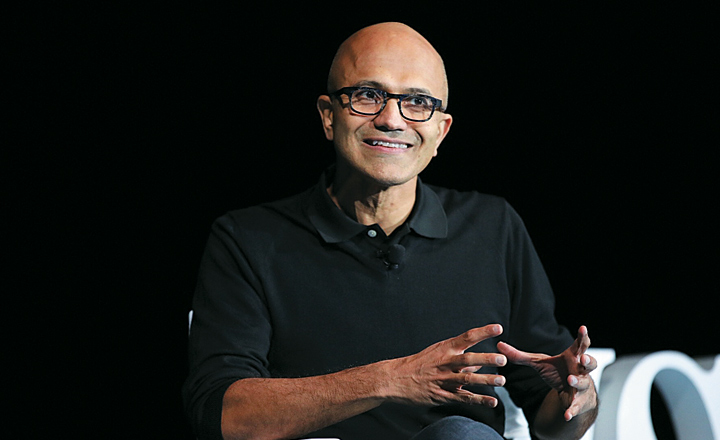The world of computing has shifted to new platforms and services — like mobile and the cloud — and is promising to head in even bolder new directions, such as virtual reality and augmented reality. So, how does one of the biggest names in computing respond to a changing landscape?
To find out, The Wall Street Journal’s editor in chief, Gerard Baker, spoke with Microsoft Chief Executive Officer Satya Nadella. Here are edited excerpts of their conversation:
Baker: Your customers are happy. Your shareholders are happy. Your employees are happy. What on Earth are you doing with Microsoft?
Nadella: I have tried to get much more focused on the sense of purpose and identity of Microsoft. We were a tools company. We were built for the hackers of the world, for the makers of the world, for the builders of the world. I have always felt that we are at our best when we express that identity with changing times. It’s about being in love with Minecraft. It’s being in love with what’s happening in AI and democratising it.
Baker: Your big bet has been cloud computing. How do you see cloud in the totality of Microsoft’s offerings, as you go forward?
Nadella: The most high-scale cloud service that Microsoft has is a Windows service, because we have one billion-plus PCs and devices, and they need to get serviced.
You need an operating system for you across all of your computing. So that’s why, whether it’s a HoloLens and mixed reality or Xbox or your PC or Surface, to us, it’s all one Windows 10 operating system. Our goal is to invent new computers and new computing.
![###<b> With AI, there has always been this argument about whether its's about replacing or argumenting [human capabilities]. I want Microsoft to fall into the augmenting camp. That's where our investments are </b>](https://s3.ap-south-1.amazonaws.com/olb-data/outlook_20230705214158.jpeg) Baker: Given how important mobile is, is that a logical development for you?
Baker: Given how important mobile is, is that a logical development for you?
Nadella: We have devices which are phones today. But the place where we are focused is, what is the unique thing that our phone can do? So for example, we have a phone that can replace your PC, the same way that we have a tablet that can replace your laptop. Those are the categories we want to create. We need some new form, new function, new value added.
Baker: What are the applications of VR?
Nadella: The ultimate computer, for me, is this mixed-reality computer, where your field of view becomes an infinite display, where you see the world. And you see virtual objects and holograms. That’s definitely what we are building today with HoloLens.
The applications of it are, of course, gaming. I would love to have Minecraft and other gaming in mixed reality. Beyond that, there are already cases of [augmented reality] fundamentally changing [things like] education. Case Western Reserve has an anatomy class that’s being taught using AR. Or what if you could get to [a home-improvement] store and, in an AR session, see what a home-improvement project should look like and then press “Order.”
I believe that every walk of life and every human activity which today is mediated by computers will be transformed by augmented reality. This is not happening tomorrow. It’s not happening next year. But that is the continuum we are on.
The future of Artificial Intelligence
Baker: What are the benefits that you’re expecting from artificial intelligence?
Nadella: It’s an amazing age in AI. We just set the world record in speech recognition, which is measured by the error rate. We have the current state of the art in object recognition, in terms of being able to take any arbitrary image and recognize the objects in it.
With AI, there has always been this argument about whether it’s about replacing or augmenting [human capabilities]. I want Microsoft to fall into the augmenting camp. And that’s where we’ve put our investments.
We have a project, Premonition. It’s an interesting research project. I think it’ll probably take us four, five years to complete.
The idea is to say, “Let’s create an early-warning system for pandemics and epidemic breakouts.” To me, being able to apply all of your machine-learning capability, your image-recognition capability, your analytics capability, your autonomous-drone stuff, to be able to create a system like that improves health would be a great way for us to make progress.
Similarly, if you say, “Well, what if AI can be applied not just to replace humans or to augment humans, but to help humans enjoy life?” One of the projects which was very stunning to me was, we took all of Rembrandt’s works, I think he has around 160,000 or so fragments, analyzed them and then had the machine create the next masterpiece.
Now, you could say, “Well, that is saying that you’re going to replace one of the greatest Dutch masters.” No, that is not the idea. The idea was to be able to say, “Can you inspire a new generation of artists by being able to bring someone from the past alive again?” So that’s another way of thinking about AI.
You can see the impact of AI through this lens of augmenting human capability, human enjoyment, human creativity. That’s the lens through which we’ll look at it.
Edited excerpts from an interview at The Wall Street Journal's WSJDLive 2016 global technology conference.











